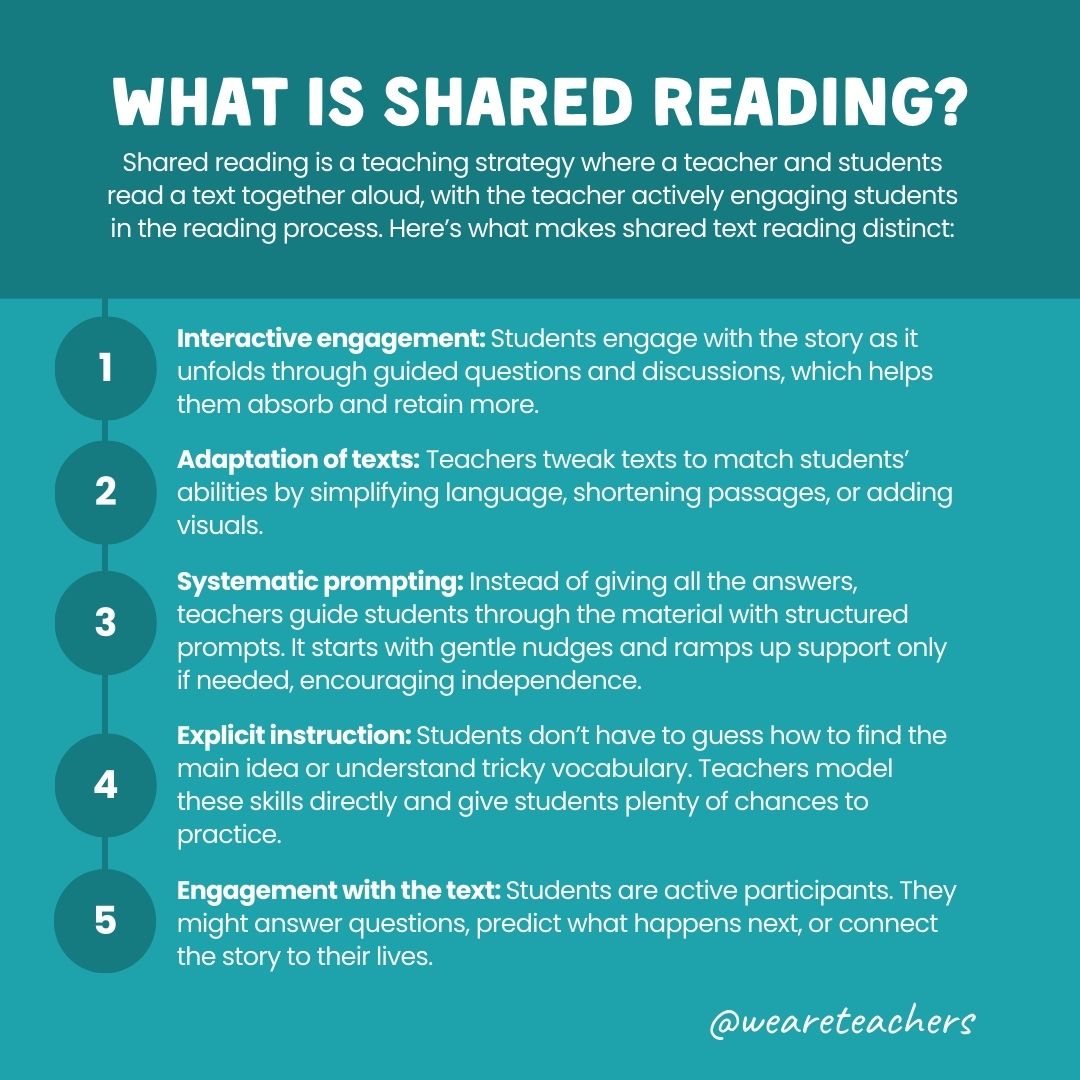For language arts teachers, finding effective ways to enhance comprehension for students with intellectual disabilities can often feel frustrating or like a dead end. There are many resources out there with claims of the best reading strategies for students with intellectual disabilities, with many teachers at their wit’s end about which strategies to use. Yet, the latest research provides a promising option for teachers noodling on this conundrum.
Shared reading is an effective strategy for students with disabilities.
Recent findings show that shared text reading can enhance the listening comprehension skills of students with intellectual disabilities. This technique transforms a traditional reading session into a dynamic learning experience by engaging students through various interactive methods like questioning, vocabulary building, and supporting comprehension.
What is shared reading?
Shared reading is a teaching strategy where a teacher and students read a text together aloud, with the teacher actively engaging students in the reading process. Here’s what makes shared text reading distinct:
- Interactive engagement. Forget passive listening. Shared reading is all about guided discussions, questions, and activities. Students engage with the story as it unfolds, which helps them absorb and retain more.
- Adaptation of texts. By tweaking texts to match students’ abilities—simplifying language, shortening passages, or adding visuals—you make them easier to grasp without losing their meaning.
- Systematic prompting. Instead of giving all the answers, teachers guide students through the material with structured prompts. It starts with gentle nudges and ramps up support only if needed, encouraging independence.
- Explicit instruction. Students don’t have to guess how to find the main idea or understand tricky vocabulary. Teachers model these skills directly and give students plenty of chances to practice.
- Engagement with the text. Students are active participants. They might answer questions, predict what happens next, or connect the story to their lives.

Key findings from Dessemontet et al. (2024):
- Effective adaptations: Adjusting text content makes reading accessible without losing its value.
- Systematic prompting: A “least-to-most” approach helps students work through challenges step-by-step.
- Explicit instruction: Teaching students how to understand “wh- words” (who, what, where) is especially impactful.
- Technological integration: Tools like e-books can add interactive elements that keep students engaged.

Can we trust this research?
Not all research holds the same value! Here’s what our We Are Teachers “Malarkey Meter” says when it comes to this publication, based on four key factors.
- Peer-reviewed? Yes! This study likely underwent multiple rounds of peer review.
- Sample size: The sample size for this meta-analysis synthesizes data from 19 studies, which is on the smaller scale but acceptable for statistical power.
- Trustworthy sources: The research team (Rachel Sermier Dessemontet, Megan Geyer, Anne-Laure Linder, Myrto Atzemian, Catherine Martinet, Natalina Meuli, Catherine Audrin, and Anne-Francoise de Chambrier) may not all have Google Scholar profiles but probably accumulate over 3,500 citations. Plus, they published in Educational Research Review, and publishing with them is very competitive!
- Methodology: The researchers utilized a multilevel meta-analysis (a study on results of many studies) for an in-depth examination of their topic. They completed each rigorous step for a meta-analysis, and their methodology is sound.
What does this mean for teachers?
This research is a call for teachers to adopt and advocate for shared-text reading practices. By integrating tailored texts and strategic prompting into reading sessions, teachers can significantly boost comprehension for students with intellectual disabilities. Our students with intellectual disabilities need more than just access to information, and shared reading might be a way to help increase their quality of life through literacy.
Embracing shared reading isn’t just about improving test scores—it’s about opening doors for our students with intellectual disabilities to connect more deeply with the world around them. These strategies for shared reading are game changers, making our classrooms places where all students can thrive. Let’s put these findings into practice and see just how much our students can grow. It’s time to roll up our sleeves and turn every reading session into an opportunity for real engagement. Ready to get started?

